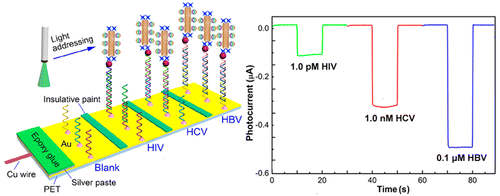当前位置:
X-MOL 学术
›
Anal. Chem.
›
论文详情
Our official English website, www.x-mol.net, welcomes your
feedback! (Note: you will need to create a separate account there.)
Ultrasensitive Photoelectrochemical Biosensing of Multiple Biomarkers on a Single Electrode by a Light Addressing Strategy
Analytical Chemistry ( IF 6.7 ) Pub Date : 2015-08-27 00:00:00 , DOI: 10.1021/acs.analchem.5b02148 Juan Wang 1 , Zhihong Liu 1 , Chengguo Hu 1 , Shengshui Hu 1
Analytical Chemistry ( IF 6.7 ) Pub Date : 2015-08-27 00:00:00 , DOI: 10.1021/acs.analchem.5b02148 Juan Wang 1 , Zhihong Liu 1 , Chengguo Hu 1 , Shengshui Hu 1
Affiliation

|
Ultrasensitive multiplexed detection of biomarkers on a single electrode is usually a great challenge for electrochemical sensors. Here, a light addressable photoelectrochemical sensor (LAPECS) for the sensitive detection of multiple DNA biomarkers on a single electrode was reported. The sensor was constructed through four steps: (1) immobilization of capture DNA (C-DNA) of different targets on different areas of a single large-sized gold film electrode, (2) recognition of each target DNA (T-DNA) and the corresponding biotin-labeled probe DNA (P-DNA) through hybridization, (3) reaction of the biotin-labeled probe DNA with a streptavidin-labeled all-carbon PEC bioprobe, and (4) PEC detection of multiple DNA targets one by one via a light addressing strategy. Through this principle, the LAPECS can achieve ultrasensitive detection of three DNA sequences related to hepatitis B (HBV), hepatitis C (HCV) and human immunodeficiency (HIV) viruses with a similar wide calibration range of 1.0 pM ∼ 0.01 μM and a low detection limit of 0.7 pM by using one kind of PEC bioprobe. Moreover, the detection throughput of LAPECS may be conveniently expanded by simply enlarging the size of the substrate electrode or reducing the size of the sensing arrays and the light beam. The present work thus demonstrates the promising applications of LAPECS in developing portable, sensitive, high-throughput, and cost-effective biosensing systems.
中文翻译:

通过光寻址策略在单个电极上的多个生物标记物的超灵敏光电化学生物传感
在单个电极上对生物标志物进行超灵敏的多重检测通常是电化学传感器面临的巨大挑战。在此,报告了一种光寻址光电化学传感器(LAPECS),用于在单个电极上灵敏地检测多个DNA生物标记。传感器通过四个步骤构建:(1)将不同目标的捕获DNA(C-DNA)固定在单个大型金膜电极的不同区域上;(2)识别每个目标DNA(T-DNA);以及通过杂交获得相应的生物素标记的探针DNA(P-DNA),(3)生物素标记的探针DNA与链霉亲和素标记的全碳PEC生物探针的反应,以及(4)PEC一对一地检测多个DNA靶标通过轻寻址策略。通过这个原则,LAPECS可以实现与乙型肝炎(HBV),丙型肝炎(HCV)和人免疫缺陷病毒(HIV)病毒相关的三个DNA序列的超灵敏检测,校正范围在1.0 pM到0.01μM之间,检测限低到0.7 pM通过使用一种PEC生物探针。此外,可以通过简单地增大基板电极的尺寸或减小感测阵列和光束的尺寸来方便地扩展LAPECS的检测吞吐量。因此,本工作证明了LAPECS在开发便携式,灵敏,高通量和具有成本效益的生物传感系统方面的有希望的应用。通过使用一种PEC生物探针可达到7 pM。此外,可以通过简单地增大基板电极的尺寸或减小感测阵列和光束的尺寸来方便地扩展LAPECS的检测吞吐量。因此,本工作证明了LAPECS在开发便携式,灵敏,高通量和具有成本效益的生物传感系统方面的有希望的应用。通过使用一种PEC生物探针可达到7 pM。此外,可以通过简单地增大基板电极的尺寸或减小感测阵列和光束的尺寸来方便地扩展LAPECS的检测吞吐量。因此,本工作证明了LAPECS在开发便携式,灵敏,高通量和具有成本效益的生物传感系统方面的有希望的应用。
更新日期:2015-08-27
中文翻译:

通过光寻址策略在单个电极上的多个生物标记物的超灵敏光电化学生物传感
在单个电极上对生物标志物进行超灵敏的多重检测通常是电化学传感器面临的巨大挑战。在此,报告了一种光寻址光电化学传感器(LAPECS),用于在单个电极上灵敏地检测多个DNA生物标记。传感器通过四个步骤构建:(1)将不同目标的捕获DNA(C-DNA)固定在单个大型金膜电极的不同区域上;(2)识别每个目标DNA(T-DNA);以及通过杂交获得相应的生物素标记的探针DNA(P-DNA),(3)生物素标记的探针DNA与链霉亲和素标记的全碳PEC生物探针的反应,以及(4)PEC一对一地检测多个DNA靶标通过轻寻址策略。通过这个原则,LAPECS可以实现与乙型肝炎(HBV),丙型肝炎(HCV)和人免疫缺陷病毒(HIV)病毒相关的三个DNA序列的超灵敏检测,校正范围在1.0 pM到0.01μM之间,检测限低到0.7 pM通过使用一种PEC生物探针。此外,可以通过简单地增大基板电极的尺寸或减小感测阵列和光束的尺寸来方便地扩展LAPECS的检测吞吐量。因此,本工作证明了LAPECS在开发便携式,灵敏,高通量和具有成本效益的生物传感系统方面的有希望的应用。通过使用一种PEC生物探针可达到7 pM。此外,可以通过简单地增大基板电极的尺寸或减小感测阵列和光束的尺寸来方便地扩展LAPECS的检测吞吐量。因此,本工作证明了LAPECS在开发便携式,灵敏,高通量和具有成本效益的生物传感系统方面的有希望的应用。通过使用一种PEC生物探针可达到7 pM。此外,可以通过简单地增大基板电极的尺寸或减小感测阵列和光束的尺寸来方便地扩展LAPECS的检测吞吐量。因此,本工作证明了LAPECS在开发便携式,灵敏,高通量和具有成本效益的生物传感系统方面的有希望的应用。











































 京公网安备 11010802027423号
京公网安备 11010802027423号